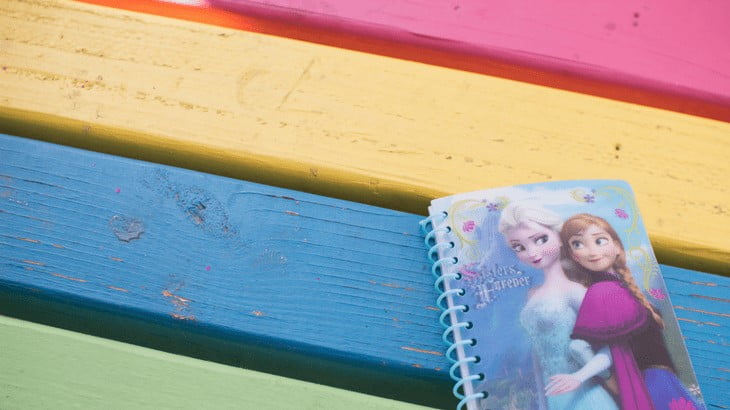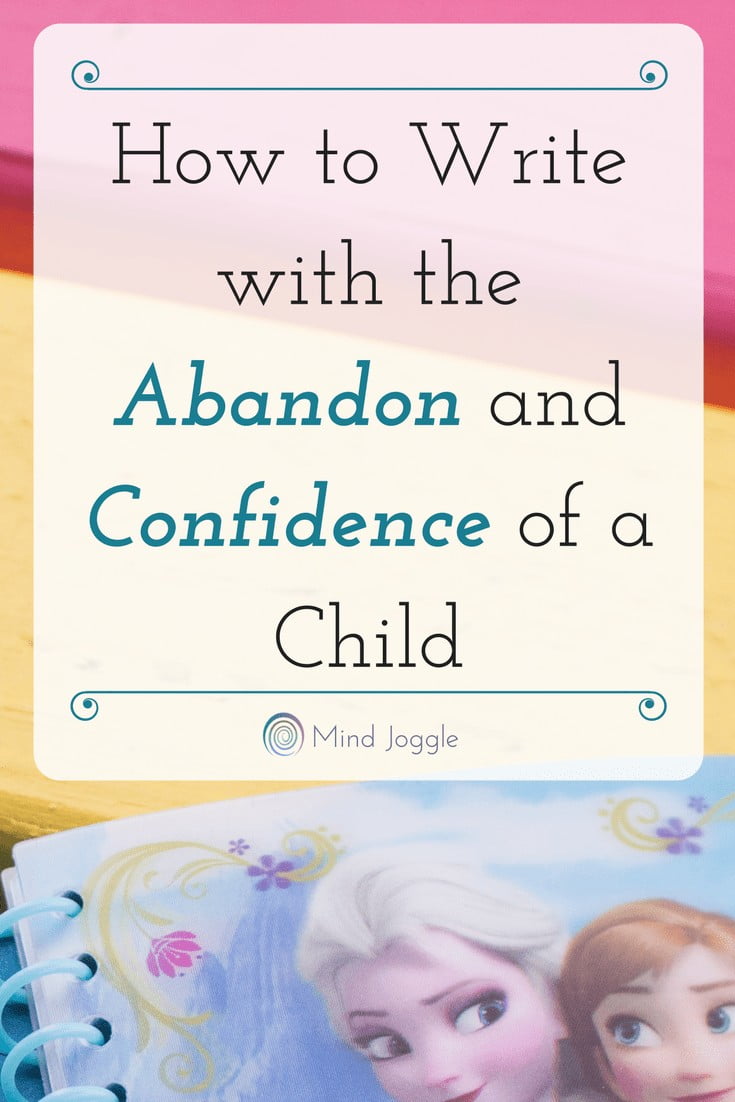How to Write with the Abandon and Confidence of a Child
Write like a child to improve your confidence, increase your productivity, and enhance the freedom and creativity you feel while writing.
This post may include affiliate links. That means if you click and make a purchase, I may earn a small commission. Please see Disclosures for more information.
One of the most difficult things we writers struggle with is getting stuck in our own heads. We procrastinate, lose our confidence, and struggle just to put words on the page. More specifically: we adult writers struggle with this. How to get past it? Write like a child.
My five-year-old has been hard at work this week on a book she’s writing and illustrating. In lieu of all of her screen time, she instead huddled over a small Frozen notebook and wrote her story. It’s about a cat chasing a dog.
Then she illustrated the story. All 44 pages of it.
But she didn’t stop there. After finishing in her little notebook, she got out the iPad, and she typed the story in Google docs. At this point in the process, she did ask me to help her spell a few words. The notebook was a rough draft, you see.

When she finished, I printed it out for her, and she re-drew the illustrations. It’s been about five days since she started, and now she’s ready to make copies and hand them out to all of the places that need them: her summer camp, the public library, her class library when she starts first grade, and our home library. Oh, and one for Santa, since he doesn’t get any presents at Christmas.
I’ve been watching her in awe this past week—her focus, her confidence, her drive to finish her project—and it occurs to me that adult writers have a lot to learn from child writers. And not just child writers that we observe now, but the writers we were as children.
Write like a child
Stories are part of childhood. Even if you didn’t have dreams of being a writer as a child, you probably spent many of your days telling stories. You played, daydreamed, acted them out.
And when you did write stories—for fun or for school—you probably did it with abandon. If there was anything you could do well, it was tell stories! And who wouldn’t want to read them?
Here are just a few of the lessons I’ve learned this week after watching my daughter write her book:
Carry a notebook. Fill it.
“Carry a notebook” is common advice for writers. Many writers probably follow it. Others, like me, buy beautiful journals in that side area of Barnes & Noble and almost never pull them out. There’s something paralyzing about that expensive notebook. The beauty, the cost, the weight of the paper; they all lend a certain gravitas to the use of it.
What I put in a notebook like that had better be worth reading and keeping forever. My little scribbles and snippets of lines that pop in my head throughout the day? Not worthy of those notebooks. I have a small, mostly empty stack of them that is testament to my paralysis.
My daughter? Used a 3” x 4” Frozen notebook. Probably as precious to her as one of my fancy journals, but she had no hesitation. That notebook needed to be filled.

I once read the advice (I think it was in Writing Down the Bones to write every day in a cheap notebook. She liked to stock up on notebooks with cartoon characters on the cover, so she didn’t take it too seriously.
The writing is the point. The act of writing. Not the notebook.
Use the small moments
A 44-page illustrated book is a big project for a five-year-old. It’s a big project for anyone, really. How did she do it? She goes to camp, plays outside, goes to soccer–she has “jobs,” like the rest of us trying to write.
But she used every spare moment she could find to work on that book.
When I was getting her sister ready to leave in the morning, she worked on a page.
After brushing her teeth for bed at night, she worked on a page.
Instead of watching a show during her screen time, she worked on a page.
She worked on it one page at a time until she had a book.
We all dream about the long stretches of time to write and get lost in our stories. If we wait for those times, they will never come and we will never have a book (or story, or article).
Waiting for the oven to pre-heat? Write a sentence. Sitting in the doctor’s office? Pull out your (cartoon) notebook.
Grab those bits of time. They add up.
Write without editing. Fix it later.
My daughter doesn’t spend a lot of time thinking about plot, structure, or character. She just writes, and she’s certain it’s good. She fixes her spelling later.
It’s hard for us adults to turn off our brains, knowing about all of these elements that we need to consider. But these elements can be even more paralyzing than the beautiful notebook.
If you have a spark—a sentence, a phrase, a scene, and entire story outline—get it down. Fix it later. Fit it in later, or trash it, if you have to. But get it down. It might be the catalyst for something great.
Write what you want to read
My daughter is certain that she is writing a story that her friends, and readers like her, will want to read. She’s not thinking about agents or publishers or book sales. She’s thinking about sharing her story with all of the people who will love it. It will go in libraries. Because, in her world, that’s where the books are.
I love the advice to write what you want to read. Sure, it can a good idea to write within a genre. But genre is not the only thing to consider. I think for every reader, there are unique elements that draw them to a story.
My daughter loves cats, and she has a love-hate relationship with our dog. Those affinities show up in her stories. I like reading about history, lifestyles vastly different from my own, animals, and stories of survival. These are probably the kinds of stories I should be writing.
Think about what you, and readers like you, would want to read. Visualize them reading it, if that helps, but don’t jump seven steps ahead to the business side of it just yet. There’s plenty of time for that once the story is finished.
Get off the page
My daughter can play for hours with her Little People figurines. We have about 30 of them and they all have names. She talks to them, puts them in different situations, and creates conflict between them. She has done this since she could talk and it’s pretty amazing to watch.
I have no doubt that some of what she plays out with her Little People makes it into her stories.
You don’t have to pull out Little People to act out your stories…but why not? Or you could grab some LEGO and build the setting. Paint faces on some rocks and have them talk to each other.
If you feel too silly doing any of that, build some Pinterest boards for your characters and your setting. Cut out pictures from magazines (does anyone still read those?) and make a collage.
Or just go for a run or walk and think about your story. Get away from the blinking curser or empty notebook and come back with fresh ideas.
Finish
I am great at starting writing projects that I never finish. For some reason, reaching an endpoint is hard for me. This seems to happen no matter the length of the project. An article or blog post can sit for days before I finally sit down and force myself to wrap it up (like I’m doing now).
My hangups are numerous: Have I said enough? Will the ending be unsatisfying? Surely there are important things I’ve left out. This ending probably seems trite. Too predictable!
My daughter had none of these reservations. She just wanted to finish, to have completed and created something. And after that first draft? She re-thought a few things, and she figured out how to make it better. But she wouldn’t have been able to without a complete first draft.
Finish.
___
Kids have so much to teach us about play, about being in the moment, and about creating. Whether you have a child to observe or not, we were all children once, and we all created with the same abandon and confidence. Remembering that feeling, and trying to recapture it again, can bring back the joy of writing and creating.
What else have you observed when watching children write or create?
Related:
Here’s Why We Have an Art Room (and Not a Playroom)




I absolutely love this post! How much we can learn from our children if we just observe them for a few moments! My son has done the exact same process multiple times. If we were to get our two together…talk about a dynamic duo! 😉
Thanks, Joy! It’s so much fun to watch them create without reservation. And what a great idea to connect them with other writers at a young age! I feel like I always read and wrote in isolation when I was a kid, and it can be such a solitary activity, but it helps to connect with others doing the same things. Kind of like we do on our blogs 🙂